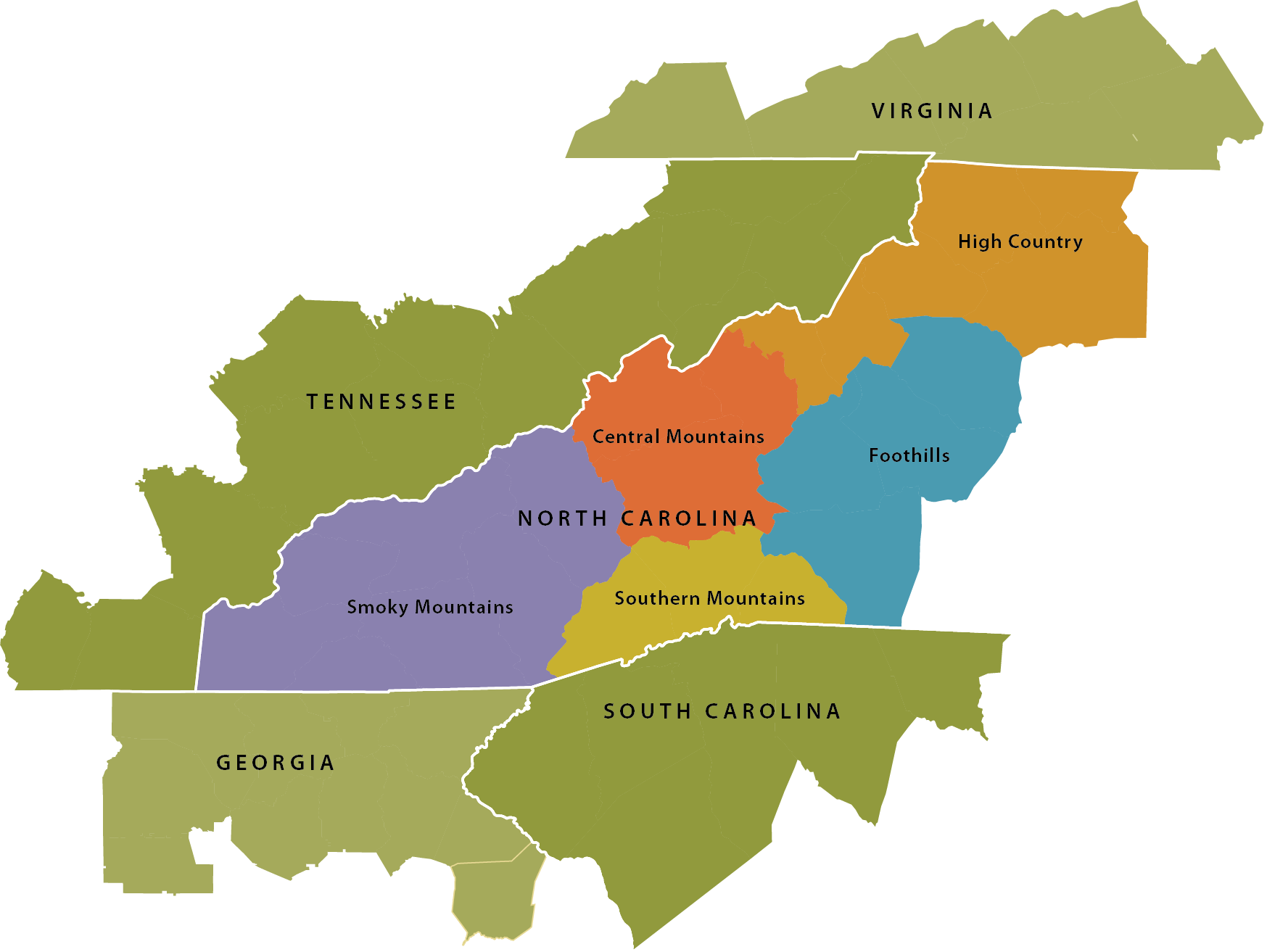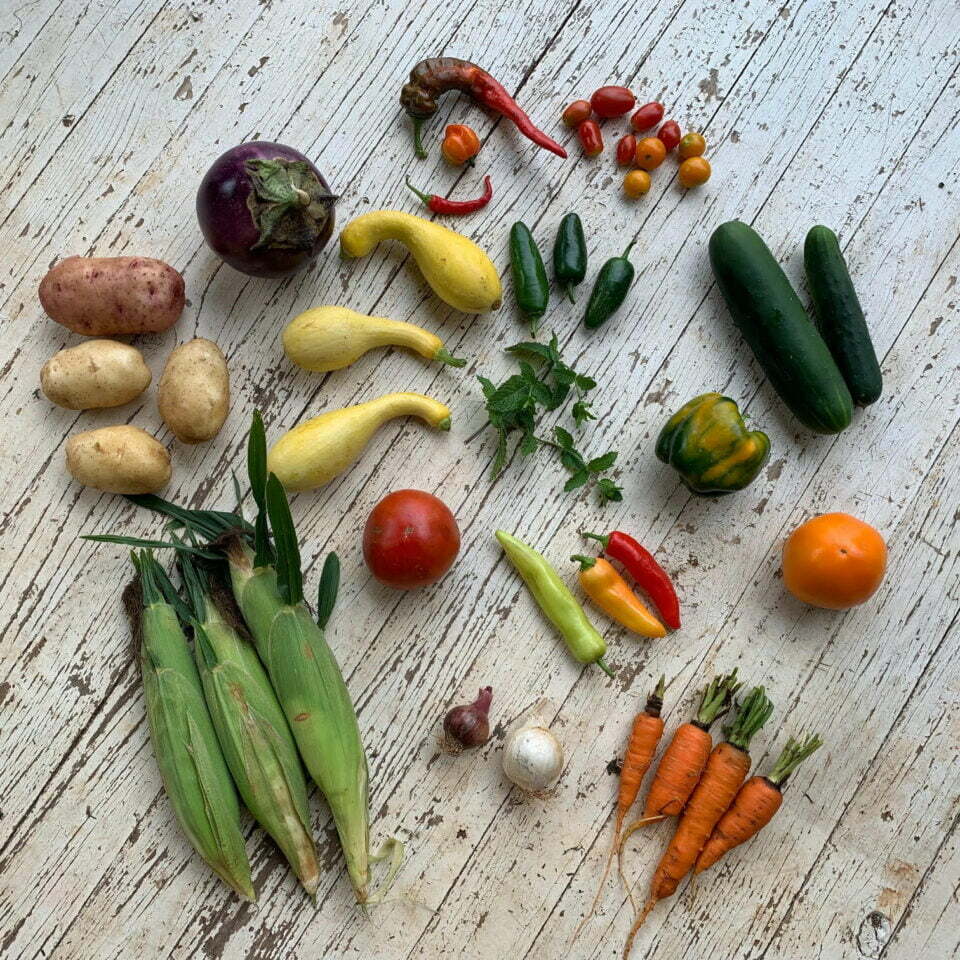Find CSA Farms
Select a region on the map to find out more about farms offering CSAs near you.
As CSAs have grown in availability and popularity, different types have developed. There are traditional CSAs offering only vegetables and some fruit, as well as CSAs with meat, eggs, and flowers. There may be choices for extended fall and winter season, online ordering, or payment plans. ASAP has organized this information to help you find the right CSA for you.

Save the Date for ASAP’s 2024 CSA Fair
WHEN: Friday, March 8, 3-5:30 p.m.
WHERE: YWCA of Asheville, 185 S. French Broad Ave., Asheville
Check out the participating farms!
CSA Fairs are a chance to meet local farmers face-to-face and learn more about CSA programs. You can ask questions about what products are included in the CSA box throughout the year, the farm’s growing practices, payment options, and pickup locations. Attendees can sign up for a CSA during the fair or follow up with farmers later. ASAP’s CSA Fair, hosted annually in March, is family-friendly, with activities for kids and community connections.
What is a CSA?

CSA stands for Community Supported Agriculture. It connects you, the consumer, directly with a local farm by purchasing weekly “shares” of a farm’s harvest upfront at the beginning of a season. With that commitment early on, the farmer is able to invest in the growing season. The traditional seasonal CSA is similar to a subscription. You’ll receive a regular—most often weekly—share of produce or other farm goods at the height of their season.
While most customers associate CSAs with produce, you can find CSAs for pasture-raised meats or fresh-cut flowers. Some farms also also offer “add-ons,” such as eggs, cheese, bread, or honey, that customers can purchase for an extra cost.
A newer CSA model is the market share or market-style CSA. You still pay upfront at the beginning of the season, but rather than receiving a pre-packed box, you meet your CSA farm at a specified farmers market and select your own produce based on the size of your share. Similarly, the buy-down model begins with a lump sum paid to the farmer. Purchases are made throughout the season until the balance reaches $0, and often you can add more to your account if needed. Some farms offer online ordering and customization as well.
A multi-farm CSA, either through partnerships between farms or through a distributor that sources from multiple farms, might offer greater diversity or consistency of product but can lessen the direct connection that exists between you and a single-farm CSA.
In a workplace CSA, employees sign on as a group and the farmer delivers boxes directly to a place of business. Employers might offer incentives or educational opportunities to encourage employees to participate and market a workplace CSA as an employee benefit. (Are you interested in organizing a workplace CSA? Find more information here.)
Why buy a CSA?
- Get the best flavor. You receive a variety of the freshest produce, picked at its peak. Find new and heirloom varieties rich in flavor and color.
- Know your farmer. You’re on a first name basis with the farmer that grew your food! As an integral member of the farm, you get to learn more about what they’re growing and how they’re growing it.
- Shorten your food supply chain. The food in your CSA box is traveling a much more direct route to your table than food you buy at a traditional grocery store.
- Experience eating with the seasons. Immerse yourself in the mountain seasons with anticipation and appreciation—tender greens in the spring and the first tomato of the summer.
- Try new things. Let the farmers harvest introduce you to new recipes and reconnect with old favorites.
- Encourage a healthy lifestyle. A weekly box of fresh produce gives you ample opportunities to infuse your diet with a wide variety of vegetables and fruits and do more cooking at home.
- Support what you value. Your commitment and financial support keeps farmers farming and preserves working farms, strengthening our capacity to build a food system that supports the wellbeing of our communities.
When do I sign up? When will I receive shares?
For a traditional spring and summer season CSA, sign up early in the year— between January and March—to secure your share. The CSA season typically begins in April or May, around the same time that farmers markets open, and lasts for 20-26 weeks. Some farms offer a fall season extension until Thanksgiving, and some even have a winter season CSA option.
What will be in my box? And how much?

There is so much variety in our region! Many farms provide a list of what kinds of produce to expect when, and if they don’t, ask for it. Typically produce farms strive to offer a wide variety of products that change with the season. In the Southern Appalachians, the first spring crops will typically include leafy greens like spinach and kale, salad mix, radishes, and green onions. In June and July you’ll start to get summer squash, tomatoes, and berries. By the end of the season, boxes will often be heavy with winter squash, potatoes, and broccoli.
Some farms offer different share sizes, often called half or full shares, which may be appropriate for different household sizes. Before signing up, ask the farmer how many types of produce and how much of each they will offer in a typical week. Ask if they’ve received feedback in the past on whether that amount was best for a family of four or could be consumed by a single person. If you are concerned about food waste and a farmer doesn’t offer smaller shares, see if you can find a friend or co-worker to split a share with you.
At some point you will likely receive an item you’re not familiar with. Most CSA customers see this as a benefit, to try something new. Ask questions! Farmers can give you tips on how to use products. They might send an e-newsletter or include printed recipes with your box. Some farms create opportunities for CSA customers to meet and interact, such as on-farm pickup times or special CSA member events like a farm dinner. You may learn cooking tecniques from your fellow CSA members.
How do I pay for it?
Paying in full before the season begins is fundamental to the CSA model, but some farms offer other options, such as installment or pay-as-you-go plans. A few farms offer a work-trade option in which shareholders assist with on-farm tasks in exchange for a reduced price or free share. Some farms set aside shares to donate to feeding sites or community members in need, and CSA members may choose to pay toward those donations as well.
Where do I pick it up?
Finding a CSA with a weekly pickup location that works with your routine is key to enjoying your CSA experience. You can scan pickup locations in the informational charts by clicking on the regions above. If you already visit a weekly farmers market, that’s a great place to start. Some CSAs might only offer on-farm pickup, but this can be a great way to connect more deeply with where the food comes from. Some farms offer delivery, usually for an additional fee. If you can gather enough interest from a group, such as a workplace, a farmer might be willing to deliver directly to you.
How do I choose?
In addition to price, pickup location, and product mix, you might also consider your personal rapport with the farmer. Talk to farmers at your local farmers market or a CSA fair to find the right fit. Another factor you may consider is the farmer’s growing practices, such as organic, biodynamic, pasture-raised, regenerative, etc. Ask farmers about their practices or find them listed at appalachiangrown.org.
Questions to ask yourself:
- Are you primarily interested in produce, or do you want to receive eggs, flowers, or other items?
- What growing practices or farm values are most important to you?
- Do you like the challenge of working with unfamiliar produce, or would you prefer to pick out what you want?
- Will you be able to make it to the pickup location each week, or could a family member or friend cover you if needed?
Questions to ask the farmer:
- What if I am out of town? Can someone else pick up my share or can I donate it?
- About how much is included in the box each week, and how does that vary throughout the season?
- Do you send a newsletter or include recipes each week?
- Do you offer opportunities to build community or have on-farm experiences?


